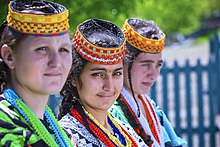 Kalash girls photographed in April 2016 | |
| Total population | |
|---|---|
| c. 3,800[1] | |
| Regions with significant populations | |
| Kalasha Valleys, Chitral District, Pakistan | |
| Languages | |
| Kalasha, Khowar | |
| Religion | |
| Majority: Animism and ancestor worship[a] with elements of ancient Indo-Iranian (Vedic- or Hindu-like) religion[b]/ Minority: Islam[2] | |
| Related ethnic groups | |
| Nuristanis, other Indo-Aryan peoples |
The Kalash (Kalasha: کالؕاشؕا, romanised: Kaḷaṣa), or Kalasha, are a small (ca. 3000) Indo-Aryan[c] indigenous (minority) people residing in the Chitral District of the Khyber-Pakhtunkhwa province of Pakistan. The term is also used to refer to several distinct Nuristani speaking people, including the Väi, the Čima-nišei, the Vântä, plus the Ashkun- and Tregami-speakers.[web 1]
According to one Kalash tradition, their ancestors migrated to Chitral Valley from Nuristan Province, Afghanistan or a location further south,[web 2][3] called "Tsiyam" in their folk songs and epics,[4] and possibly located near Jalalabad and Lughman in Afghanistan. Another tradition claims descent from the Greco-Bactrian and Indo-Greek kingdoms, which emerged following Alexander's expedition into the region. While these kingdoms exerted influence over parts of modern-day Pakistan, no evidence exists to suggest that they directly controlled or significantly impacted the Chitral Valley.[web 3][web 4][d][5]
They are considered unique among the people of Pakistan,[web 2][web 1][6] and form Pakistan's smallest ethnoreligious group,[web 5] practicing what authors consider as a form of animism and ancestor worship[a] with elements of Indo-Iranian (Vedic- or Hindu-like) religion.[b]
- ^ "The last of the Kalasha". 24 February 2019.
- ^ Ahmed 1986, p. 23–28.
- ^ Nicolaisen, Johannes; Yde, Jens (1963). Folk: dansk etnografisk tidsskrift. Dansk etnografisk forening.
- ^ East and West. Istituto italiano per il Medio ed Estremo Oriente. 1992.
- ^ Cacopardo, Augusto (2011). "Are the Kalasha Really of Greek Origin? The Legend of Alexander the Great and the Pre-Islamic World of the Hindu Kush". Acta Orientalia. 72: 47–92. doi:10.5617/ao.4847.
- ^ Cacopardo 2016, p. 28.
Cite error: There are <ref group=lower-alpha> tags or {{efn}} templates on this page, but the references will not show without a {{reflist|group=lower-alpha}} template or {{notelist}} template (see the help page).
Cite error: There are <ref group=web> tags on this page, but the references will not show without a {{reflist|group=web}} template (see the help page).